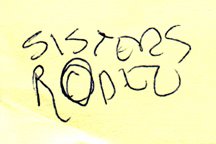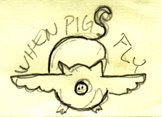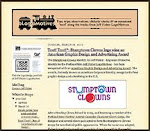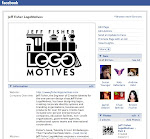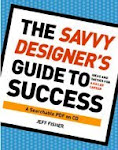 Having created identities for several law firms over the years, I was recently asked to write a piece on identity design for the Spring 2006 issue of Legal Manage- ment News: The Journal of the Association of Legal Administrators - Oregon Chapter. The text of that article follows:
Having created identities for several law firms over the years, I was recently asked to write a piece on identity design for the Spring 2006 issue of Legal Manage- ment News: The Journal of the Association of Legal Administrators - Oregon Chapter. The text of that article follows:When initiating the task of establishing a new corporate identity, most businesses find themselves wandering (or stumbling) into foreign territory. The following tips will assist those taking on such a project, making the design process a bit easier when dealing with “creative types” in solving a firm’s identity crisis.
Do not try this at home
Having a computer, and design software programs, does not make an individual an identity designer. Hire a professional to create your business logo – a basic element of your “brand.” Not all graphic designers, or design studios, specialize in identity design. Do your research in selecting the designer, or firm, to best fulfill the specific requirements of your corporate identity project. Seek referrals from businesses previously working with identity firms, flip through logo and identity design books at a local bookstore for design styles you like, or review portfolios of designers – in person or online – until you find the design professional best fitting your needs. Select someone with whom you will “play” well. Larger corporate identity projects and continuing branding efforts may evolve into a form of marriage between a business and a creative company.
The K.I.S.S. Principle
Nearly 30 years ago an instructor introduced me to the K.I.S.S. Principle of design; which translates to: Keep It Simple, Stupid. It does convey a very important design consideration. Simple logos are often the most easily recognized and memorable. Remember, the basis of the international branding for the world’s largest shoe manufacturer is a very simple graphic swoosh. The identity process for the Portland law firm Samuels Yoelin Kantor Seymour & Spinrad went through numerous sometimes complicated iterations before coming back to an early, very simple, concept of two thick law books creating the “S” letterform – representing the name Samuels, designated as the one constant in any future name changes. The icon has served the company well for the past decade.
Seeing your business image in black and white
When asked for the most important considerations in designing a logo, the K.I.S.S. Principle (above) is number one, followed closely by “make sure your logo works well in black and white.” Even in this time of technical and cyber marvels it is important for a business identity to translate clearly and professionally in black and white for the copying, faxing and scanning of required documents. In addition, a logo should initially be created in a vector-based illustration program (such as Adobe Illustrator or Macromedia Freehand) allowing for digital flexibility and easy usage in all applications your business may require, from a stationery package to signage. Those basic files will allow a designer to create and provide all the digital resources required to implement the identity into your internal systems. The frequently misused “bells and whistles” of some computer programs, put into action for 3-D effects, beveled edges, skewed type, gradients and other often-unnecessary graphic treatments, may create distractions from the readability and success of a corporate identity.
A graphic and financial investment in your corporate future
The creation of your logo, one of the most important and visible elements of your corporate image, should be regarded as an investment in the future of your firm’s marketing, promotion, advertising and community presence. That investment will include the actual costs of incorporating the new identity into your stationery, signage, web site, marketing efforts and much more. Designers do occasionally create over-the-top identities that may evolve into unnecessarily costly production and printing expenditures. Determine if your identity will really require a spendy four-color printing process. Evaluate whether embossing and foil-stamping are necessary on stationery used daily – especially when that expense may literally be flattened and melted by an overheated laser printer. Trendiness in a corporate identity may be a costly mistake as well. A logo should have some longevity and connect with a firm’s clientele and history in a positive manner. Shapes, colors and type treatments need to be evaluated for appropriateness. For example, the swooshes and arcs so prevalent in the dot com explosion of the last decade, now convey the negative connotation of the business doom of that time. In judging recent international design awards I have reviewed countless business identities using various shades of green and orange (individually and together); colors that will soon seem very dated. Unique, conservative and professional type treatments, beyond the limited, over-used font selections installed on a basic computer system, will set a business apart from the trendy appearances of other companies.
Putting your money where your logo is
Confirm that your company is ready to make that investment – emotionally and financially – in a new business identity and then revisit the supposedly final selection again. In 1998, the Portland firm now known as Smith Freed & Eberhard had expended a great deal of time, energy and resources in the selection of a new corporate identity. Many printed elements of the new image had already been produced and implemented. However, there was one major problem with the new logo. In the alphabet soup of the firm name at the time – Smith Freed Heald & Chock – the placement of the typographical elements within the logo did not correspond to the proper order of the partner’s initials in the business name. When it came time to cast the logo in bronze for the lobby signage the “powers that be” balked at spending thousands of dollars to create the over-sized plaque with the partner initials in the incorrect order. At that time I was brought in to completely redesign the firm’s identity – and have revised that design twice in the years since with changes in the corporate name.
Thoughtful planning, extensive research, attention to details, and excellent communication – with internal decision-makers and your design professional – will tip the scales in the direction of a successful corporate identity design.
This entry was originally posted on bLog-oMotives on 05.05.06.
© 2008 Jeff Fisher LogoMotives






